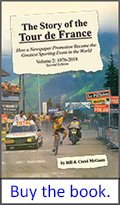

Wheel Building:
Part 3: A Closer Look at Spoke Tension
by John Neugent
Tech articles | Commentary articles | Wheel building part 2 | Wheel building part 4
The late John Neugent probably knew more about bicycle wheels than anyone else. Maybe more about bikes as well. He spent his life in the bike business, at every level. He owned Neugent Cycling, a firm devoted to delivering world-class equipment at the lowest possible price. —Chairman Bill

John Neugent

Bill and Carol McGann's book The Story of the Tour de France, Vol 2: 1976 - 2018 is available as an audiobook here. For the print and Kindle eBook versions, just click on the Amazon link on the right.
John Neugent writes:
What’s the big deal about spoke tension?
When I first started building wheels in the early '70s there were no spoke tension meters. Most wheels had 36 spokes and there was no need for them. Then in the late '80s, Mavic was the first to introduce wheel systems. They made their own hubs and rims and combined them with fewer spokes. This made them lighter and more aerodynamic (spokes are like egg beaters in the air). It also made the quality of the spoke and the wheel build more critical.
They started using higher spoke tensions primarily because the lower spoke count wheels require the build to be better so that the wheel stays straight longer. Thus the desire for high and equal tension – most importantly on the drive side rear spokes. Those will invariably be the tightest because the wheel is dished (offset) to accommodate the gears.
To understand spoke tension, it’s important to understand the dynamics of a wheel. Spoke tension does not affect wheel stiffness. As long as a spoke has some tension the wheel will be as stiff as if it were in high tension. Therefore the goal in a wheel build is to prevent a spoke from loosening, in particular the non-drive spokes of the rear wheel.
The non-drive side of a rear wheel will always have the lowest tension of any spokes on a bike. It is also not specified because it’s a result of pulling the rim to center. If you had a spec it could result in an off center rim. Asymmetric rims normally move the center of the rim about 4 mm or so off center to increase the tension in the non-drive side spokes. It’s not a big advantage, but it is an advantage.
Therefore, the reason for the spoke tension on the drive side rear to be high is to increase the tension on the non drive side – to prevent them from loosening. Also, when you install a tire and bring it up to pressure you reduce the tension of the spokes – which only makes sense since you are pressuring the tube to about 90 psi or so. The very good news is that when you ride, the spoke tension does not increase. The wheel is a suspension system and the spokes on the “top” don’t increase tension but rather the spokes on the “bottom” decrease tension.
High quality wheels generally have drive side rear spoke tension anywhere from 130 kgf on up to 155 kgf. I use the higher tension in order to get the non-drive spokes higher. But I also use dual internal washers to both increase the rim strength and to ease the build of the wheel. It’s not uncommon for a nipple to seize up at that tension without using the washers.
Front wheels seldom have any issues so spoke tension can be lighter. Many people build to 115 kgf, we use 130 kgf.

Lower spoke-count wheels require higher spoke tensions.
Equal tension is also important because any unequal tension will have a tendency to equalize itself over time – making the wheel become untrue. Equal tension is primarily a result of the radial run out (roundness). We use dial indicators showing run out to the 1/1000th of an inch (we shoot for 5/1000th). Another somewhat common method to equalize spoke tension is plucking the spokes and equalizing the tone but it’s my experience that if we are at out spec of 5/1000th the tone is within one note. It’s also really important on the drive side rear because those are the key spokes in wheels.
It’s not uncommon for someone to ask me what their spoke tension should be. I always tell them if they got the wheels from us not to really worry about it unless they are rebuilding a wheel from scratch.
The tensions I mention are much higher than the tensions on wheels with more spokes. This dramatically increases the need for a quality wheel builder. When you use high tension, the key is to turn the nipple at high tension as little as possible. Each turn rounds out the spoke hole in the rim, weakening it (another major reason for the dual internal washers – which prevent the hole from rounding out). The more wheels you build, the faster you get, and the fewer times you turn the nipples. With a laced wheel, a good builder can normally build a front wheel in 10 minutes and a rear in 15. An inexperienced builder may take an hour – all of that extra time is weakening the rim and nipples.

Blue Loctite 242, the wheelbuilder's friend.
One final point. In the old days, we used boiled linseed oil for a lube. It hardens up and helps prevent the nipples from loosening. Now most builders use Loctite. I use 242 (blue). Because the tensions are so high on the drive side, a good trick is to heat up the nipple of you need to turn on the drive side as this will tend to loosen the Loctite.
John Neugent was was one of the first to establish quality hand building in Taiwan around the turn of the century. He now owns Neugent Cycling, a firm devoted to delivering world-class equipment at the lowest possible price.







